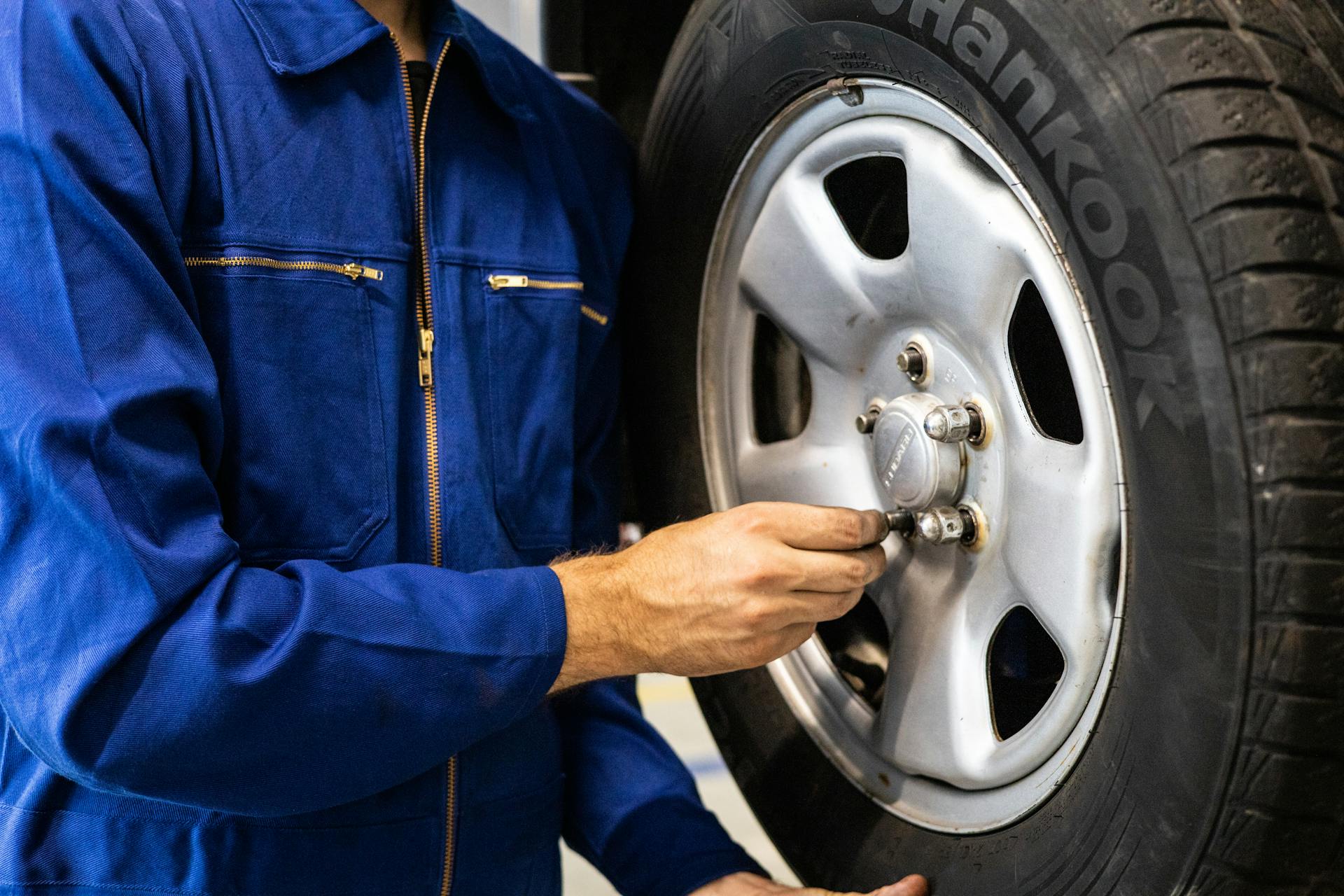Got a faulty tire pressure sensor? This guide outlines ten essential steps to replace a TPMS sensor, ensuring accurate tire pressure monitoring. Perfect for garage maintenance or fixing a warning light, these steps help you swap the sensor confidently, keeping your car safe on the road.
1. Gather Necessary Tools and Parts
Replacing a TPMS sensor requires specific tools and a compatible sensor. Having everything ready ensures a smooth process, whether at home or a shop.
A TPMS replacement kit and tools are affordable and critical for success. Here’s what you need to start.
-
Get a TPMS sensor. Purchase a compatible sensor ($20-$50) for your car’s make and model, available at auto stores.
-
Use a valve core tool. A tool ($5-$10) removes the valve core and aids sensor installation, essential for valve stem types.
-
Grab tire tools. Include a jack, lug wrench, and tire iron for wheel removal, costing $20-$50 if not included.
-
Have a TPMS scan tool. A scan tool ($30-$100) reprograms or activates the new sensor, ensuring functionality.
2. Verify the Faulty Sensor
Before replacing, confirm which TPMS sensor is faulty to avoid unnecessary work. A malfunctioning sensor triggers a dashboard warning light or low-pressure alert.
Checking the sensor saves time and ensures you replace the correct one. Here’s how to verify the issue.
-
Check the TPMS light. A steady or flashing dashboard light indicates a faulty sensor, triggered after driving.
-
Use a TPMS scan tool. Scan each tire to identify the malfunctioning sensor, taking 2-5 minutes, costing $0 if you own the tool.
-
Inspect visually. Look for physical damage on the sensor or valve stem, accessible after tire removal.
-
Confirm with a shop. If unsure, a mechanic verifies the fault for $20-$50, ensuring accurate replacement.
3. Park on a Safe, Flat Surface
Park your car on a flat, stable surface to ensure safety during the TPMS sensor replacement. This prevents rolling or tipping while working on the tire.
A level garage floor or paved driveway is ideal for stability. Here’s how to set up safely.
-
Choose a flat spot. Park on a driveway or garage floor to keep the car stable during the process.
-
Engage the parking brake. Set the brake firmly to prevent movement, ensuring a safe workspace.
-
Use wheel chocks. Place chocks or heavy objects ($0-$20) behind opposite tires for added security.
-
Activate hazard lights. If roadside, turn on lights to alert others, enhancing safety during setup.
4. Loosen the Lug Nuts
Loosen the lug nuts on the wheel with the faulty sensor before lifting the car. This prepares the tire for removal and simplifies the process.
Do this on the ground to avoid wheel spin. Here’s how to loosen the nuts effectively.
-
Use a lug wrench. Fit the wrench onto each nut and turn counterclockwise, costing $0 if included with the car.
-
Apply firm pressure. Use body weight for tight nuts, loosening each one full turn, taking 2-3 minutes.
-
Follow a star pattern. Loosen nuts in a crisscross order to release pressure evenly, preventing wheel damage.
-
Keep nuts safe. Store lug nuts in a container to avoid losing them during the process.
5. Lift the Car with a Jack
Lift the car using a jack to access the tire and sensor. Proper jack placement ensures a safe lift, critical for removing the wheel.
Correct positioning prevents damage to the car’s frame. Here’s how to lift the vehicle safely.
-
Find the jack point. Locate the reinforced area near the tire, specified in your car’s owner’s manual.
-
Position the jack. Place it under the pinch weld or frame, ensuring stability, costing $0 with a car jack.
-
Raise the car. Crank the jack until the tire is 2-3 inches off the ground, taking 2-3 minutes.
-
Ensure stability. Check that the car is steady to avoid tipping during sensor replacement.
6. Remove the Tire
Remove the tire to access the TPMS sensor, typically mounted on the valve stem or wheel’s inner rim. This involves unscrewing lug nuts and pulling off the wheel.
Careful removal ensures a smooth process. Here’s how to take off the tire.
-
Unscrew lug nuts. Fully remove the loosened nuts with the lug wrench, placing them in a safe spot.
-
Pull off the tire. Grip the tire and pull it straight off the wheel studs, taking 1-2 minutes.
-
Lay the tire flat. Set it on the ground to prevent rolling, keeping the workspace organized.
-
Clean the hub. Clear debris from the hub to ensure a clean remounting later.
7. Remove the Old TPMS Sensor
Remove the faulty TPMS sensor from the valve stem or wheel. This step involves deflating the tire and extracting the sensor, often integrated with the valve stem.
Proper removal prevents damage to the rim. Here’s how to extract the old sensor.
-
Deflate the tire. Use a valve core tool ($5-$10) to remove the core, releasing air in 1-2 minutes.
-
Remove the sensor. Unscrew or pull the sensor from the valve stem or rim, taking 2-3 minutes.
-
Use care with the rim. Avoid scratching the rim, which could cost $50-$200 to repair if damaged.
-
Inspect the mount. Check the valve hole or sensor mount for debris, ensuring a clean fit.
8. Install the New TPMS Sensor
Install the new TPMS sensor onto the wheel or valve stem to restore tire pressure monitoring. This step requires precise fitting to ensure a proper seal and function.
A secure installation prevents leaks and ensures accuracy. Here’s how to install the new sensor.
-
Insert the new sensor. Push the TPMS sensor or valve stem through the rim’s hole, costing $20-$50.
-
Secure the sensor. Tighten the nut or snap the sensor into place, taking 2-3 minutes with a tool.
-
Check the seal. Ensure the sensor’s gasket is flush against the rim to prevent air leaks.
-
Lubricate if needed. Apply soapy water to ease installation, avoiding damage to the sensor or rim.
9. Reinstall the Tire and Inflate
Reinstall the tire and inflate it to the proper pressure after installing the new sensor. This step restores the wheel and ensures the TPMS functions correctly.
Proper mounting and inflation ensure safe driving. Here’s how to complete this step.
-
Mount the tire. Align the wheel with the studs, push it on, and hand-tighten lug nuts, taking 2-3 minutes.
-
Lower the car. Gently lower the car using the jack, ensuring stability, costing $0.
-
Tighten lug nuts. Use a star pattern to tighten nuts fully, taking 2-3 minutes with a wrench.
-
Inflate the tire. Use a compressor to reach 30-35 PSI, checking with a gauge ($5-$20).
10. Program and Test the TPMS Sensor
Program the new TPMS sensor to sync with your car’s system and test for functionality. This ensures the sensor communicates accurate pressure data to the dashboard.
Proper programming avoids warning lights and ensures safety. Here’s how to finalize the process.
-
Use a TPMS scan tool. Activate or program the sensor to sync with the car, taking 5-10 minutes, costing $30-$100 for the tool.
-
Test for functionality. Drive briefly to check if the TPMS light clears, confirming the sensor works.
-
Check for leaks. Spray soapy water on the stem; no bubbles mean a secure seal, taking 1-2 minutes.
-
Visit a shop if needed. If programming fails, a mechanic syncs it for $20-$50, ensuring accuracy.
Conclusion
Changing a tire pressure sensor is manageable with these ten steps, from gathering tools to programming the sensor. Fix faults confidently and drive safely.
For professional help, our mobile tire change service connects you to trusted tire professionals 24/7. Keep your TPMS in top shape!







